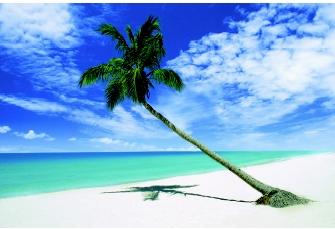Oceans, Tropical
Tropical oceans encircle Earth in an equatorial band between the Tropic of Cancer (23.5° North latitude) and the Tropic of Capricorn (23.5° South latitude). * The central portions of the Pacific and Atlantic Oceans and most of the Indian Ocean lie in the tropics. The warm tropical oceans play a critical role in regulating Earth's climate and large-scale weather patterns. Much of the planet's biological diversity resides in the tropics, and the global distribution of species and ecosystems depends on oceanographic and atmospheric processes that occur in the equatorial oceans.
Heat from the Sun drives global circulation of Earth's oceans and atmosphere. Much of that critical solar radiation initially falls on the tropics, where the Sun lies almost directly overhead for the entire year. The water temperature of tropical oceans thus typically exceeds 20°C (68°F) and stays relatively constant throughout the year. Particularly intense radiation directly over the equator evaporates seawater and forms a mass of very warm, humid tropical air that subsequently rises and cools as it flows north and south. Because cool air holds less moisture than warm air, the water vapor quickly condenses into clouds and falls as precipitation. Heavy, warm, yearround rains are a hallmark of Earth's tropical regions. Fragile, biologically diverse ecosystems such as rainforests and coral reefs thrive in the warm, wet tropics.
Uneven heating of the sea surface between the tropics and the poles creates heat-driven convection currents in the atmosphere and oceans. * Vertical circulation in the tropical oceans also affects the distribution of heat and biological nutrients throughout the global ocean. In general, surface water sinks at downwellings where surface currents flow toward a continental coastline, or where two surface currents converge. Deep ocean water rises to the surface at upwellings where surface currents flow away from land, or where surface currents diverge. Tropical downwellings transfer heat and nutrients to the deep-ocean circulation system. At tropical upwellings,

Tropical upwellings support huge populations of microscopic plants and animals called phytoplankton and zooplankton. Plankton, in turn, feed many species of fish and other marine life, and humans who depend on fish for food. Tropical fisheries account for about half of the world's fish catch, even though tropical oceans represent only 0.01 percent of Earth's ocean volume.
Coral reefs are another well-recognized feature of tropical oceans. The seas surrounding tropical islands and low-latitude continental shelves away from major river deltas are ideal for coral reef formation. Over millennia, very large reefs have formed in the Caribbean Sea, and especially in the southwest Pacific Ocean. For example, the Great Barrier Reef of northeastern Australia covers thousands of square kilometers.
SEE ALSO Carbon Dioxide in the Ocean and Atmosphere ; Climate and the Ocean ; Corals and Coral Reefs ; El NiÑo and La NiÑa ; Ocean Currents ; Ocean Mixing ; Plankton ; Weather and the Ocean .
Brian D. Hoyle
and Laurie Duncan
Bibliography
Open University Course Team. Ocean Circulation. Oxford, U.K.: Pergamon Press, 1993.
Press, Frank, and Raymond Siever. Understanding Earth. New York: W.H. Freeman and Company, 2001.
Ross, David A. Introduction to Oceanography. New York: Harper Collins College Publishers, 1995.
Turk, Daniela, Michael J. McPhoden, Antonio J. Busalacchi, and Marlon R. Lewis. "Remotely Sensed Biological Production in the Equatorial Pacific." Science 293 (July 20, 2000): 471–474.
* See "Climate and the Ocean" for an illustration of circulation zones.
* See "Climate and the Ocean" for an illustration of the tropical zones.